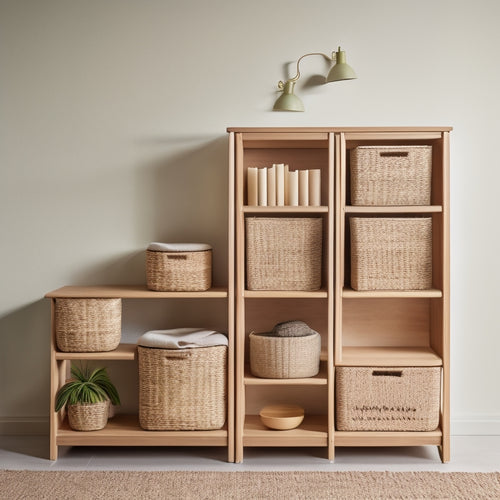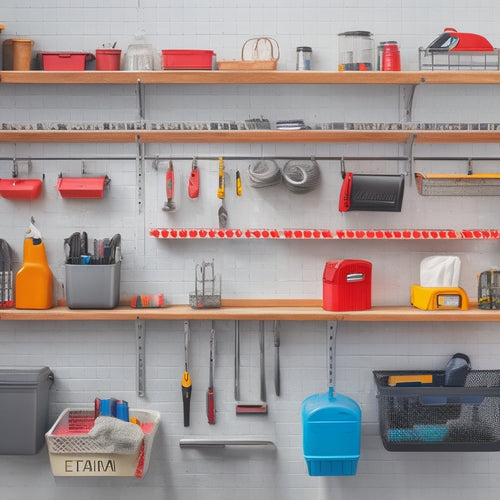
Streamline Your Garage: Tool Organization Essentials
Share
You're likely wasting up to 30% of your garage's potential due to inefficient tool storage. To maximize space and productivity, start by evaluating your garage's dimensions, doors, windows, and obstacles. Purge and declutter tools, then categorize them by type, frequency of use, and task-based clusters. Assign zones for tools, utilizing vertical storage solutions like tool racks, wall hooks, and pegboards. Label and sign tools for easy access, and implement a regular maintenance and rotation schedule. By streamlining your garage, you'll work more efficiently and effectively - and you'll discover even more ways to optimize your space as you go.
Key Takeaways
• Assess your garage space by noting dimensions, obstacles, and traffic flow to optimize tool storage and organization.
• Purge and declutter your tools by categorizing them by type, frequency of use, and task-based clustering for a more efficient garage.
• Utilize vertical storage solutions like tool racks, wall hooks, and overhead storage to maximize storage capacity and reduce clutter.
• Implement a labeling and identification system using color coding, unique identifiers, and signs to ensure easy access and maintenance of tools.
• Designate zones for tool storage, maintenance, and rotation to prolong tool lifespan and ensure a well-organized workshop.
Assessing Your Garage Space
Take stock of your garage's dimensions, noting the location and size of doors, windows, and any obstacles that could impact tool storage and workflow. This pivotal step will help you maximize space and create an efficient garage layout.
Measure the length, width, and height of your garage, including any alcoves or recesses. Identify the 'dead zones' where tools and equipment can't fit or are hard to reach.
Next, consider the 'work zones' where you'll be using your tools. Will you need a dedicated area for a workbench or a space for a table saw? Think about the 'traffic flow' in your garage, ensuring there's enough room to move around comfortably.
Garage layout suggestions include allocating corners for shelving units or cabinets, and reserving walls for pegboards or hooks. By evaluating your garage's unique dimensions and requirements, you'll be able to create a tailored space that boosts productivity and reduces frustration.
Purge and Declutter Tools
As you start purging and decluttering your tools, you'll need to identify unwanted tools that are no longer serving a purpose or are redundant.
Next, sort your tools by type, grouping similar items together, such as all your wrenches or screwdrivers.
Identify Unwanted Tools
You're likely harboring tools that no longer serve a purpose, and it's essential to identify these unwanted items to free up valuable space and mental energy in your workshop. Take a closer look at your tools and be honest with yourself – when was the last time you used that rusty old wrench or that broken drill bit? It's time to let go of tools that are beyond repair or no longer useful.
| Tool Condition | Action |
|---|---|
| Broken or damaged beyond repair | Recycle or dispose of responsibly |
| Still functional but no longer needed | Donate to a local charity or sell |
| Unused but still in good condition | Repurpose or upcycle into something new |
Sort Tools by Type
Now that you've purged your tool collection of unwanted items, sort the remaining tools into categories based on their function, such as hand tools, power tools, and measuring instruments, to create a logical and efficient organizational system.
This will enable you to quickly locate the tool you need, reducing wasted time and increasing productivity.
Divide hand tools into subcategories like wrenches, pliers, and screwdrivers, and power tools into drills, saws, and sanders.
Consider storage solutions that cater to each tool type, such as hanging pegboards for hand tools and shelving units for power tools.
Implementing a tool organization system will also facilitate tool maintenance, ensuring your tools remain in good condition and prolonging their lifespan.
By grouping similar tools together, you'll be able to identify which tools require maintenance, making it easier to perform routine tasks like cleaning and sharpening.
With a well-organized tool collection, you'll be able to work more efficiently, completing tasks quickly and effectively.
Remove Broken Items
How many broken or damaged tools are currently cluttering your workspace, hindering your productivity and creating frustration? It's time to take action and remove them to create a more efficient and organized garage. Start by identifying tools that are beyond repair and consider recycling old items responsibly. This won't only free up space but also reduce waste and minimize environmental impact.
For tools that can be salvaged, decide whether to repair or replace them. If you're handy, you might be able to fix minor issues, but if the damage is extensive, it's often more cost-effective to replace the tool altogether. Consider the tool's age, condition, and whether it's still serving its purpose.
Categorize Tool Groups
When categorizing tool groups, you'll need to ponder three key points: tool type segregation, frequency of use, and task-based clustering.
By separating your tools into distinct categories based on their type, you'll make certain that similar tools are stored together, making them easier to find and access.
Next, you'll want to organize your tools by how frequently you use them, and finally, group them by the tasks they're used for, streamlining your workflow and boosting productivity.
Tool Type Segregation
Categorizing your tools into distinct groups based on their function or characteristics is an essential step in effective tool organization, allowing you to quickly identify and access the right tool for the task at hand.
This process, known as tool type segregation, helps you maintain a clutter-free workspace and reduces the time spent searching for tools. By grouping similar tools together, you can also ensure that they receive proper tool maintenance, such as cleaning and lubrication, and are stored in an organized manner for best tool storage.
Here are some examples of tool groups you can create:
- Hand tools (wrenches, pliers, screwdrivers)
- Power tools (drills, saws, sanders)
- Automotive tools (socket sets, air compressors, diagnostic equipment)
- Fastening tools (nail guns, staplers, rivet guns)
Frequency of Use
You can further refine your tool organization system by categorizing your tool groups based on their frequency of use, making sure that the tools you need most often are easily accessible and well-maintained. This approach allows you to prioritize tool maintenance and allocate storage solutions accordingly. By grouping tools into high, medium, and low usage categories, you can optimize your organization effectiveness.
High-usage tools, such as hammers and screwdrivers, should be stored in convenient and easily accessible locations, like pegboards or tool chests.
Medium-usage tools, like pliers and wrenches, can be stored in nearby cabinets or on shelves.
Low-usage tools, such as specialized equipment or seasonal tools, can be stored in less accessible areas, like overhead storage or bins.
This categorization system enables you to allocate your time and resources more efficiently, focusing on maintaining and updating your most frequently used tools. By doing so, you'll make sure that your tools remain in good condition, ready to tackle any project that comes your way.
Task-Based Clustering
Five distinct task-based clusters can be created by grouping tools according to the specific tasks or projects they're used for, allowing you to access the necessary tools quickly and efficiently. This approach enables you to prioritize your tools based on the tasks you need to accomplish, streamlining your workflow and optimizing your time management.
By categorizing your tools into task-based clusters, you'll be able to identify the most critical tools for each project, making tool prioritization a breeze.
Here are some examples of task-based clusters you can create:
-
Automotive cluster: containing tools for car maintenance, repair, and customization
-
Woodworking cluster: housing tools for carpentry, woodworking, and furniture making
-
Electrical cluster: featuring tools for electrical work, wiring, and circuitry
- General repair cluster: including tools for general maintenance, repair, and DIY projects
Assign Zones for Tools
Divide your workspace into designated zones, each housing a specific type of tool, to maintain a logical and efficient tool organization system. This approach allows you to quickly locate the tools you need, reducing downtime and increasing productivity.
Consider implementing color-coded zones to categorize tools by type, such as hand tools, power tools, and automotive tools. This visual system makes it easy to identify where each tool belongs, promoting efficient storage and retrieval.
Within each zone, utilize a combination of tool racks and hanging solutions to maximize storage capacity. For example, install a pegboard with hooks and bins to store frequently used items, such as hammers and screwdrivers. Reserve wall-mounted shelves for less frequently used tools, like specialized automotive diagnostic equipment.
Utilize Vertical Storage
Efficient use of wall space is crucial in maximizing tool storage capacity, and by installing shelving units, cabinets, or slatwalls, you can capitalize on the often-underutilized vertical real estate in your workspace. This allows you to store more tools in a smaller footprint, keeping your garage floor clear and reducing clutter.
Some essential components when utilizing vertical storage include:
-
Tool racks: Perfect for storing long-handled tools like brooms, shovels, and rakes, keeping them organized and within easy reach.
-
Wall hooks: Ideal for hanging items like bikes, extension cords, and hoses, keeping them off the floor and freeing up valuable space.
-
Overhead storage: Take into account installing overhead storage bins or racks to store infrequently used items like seasonal decorations or out-of-season tools.
- Magnetic strips: Add magnetic strips to your walls or cabinets to store small metal tools and accessories, keeping them organized and easy to find.
Invest in Tool Pegboards
When you invest in tool pegboards, you'll need to decide on a layout that maximizes your workspace efficiency.
You'll have to choose from various pegboard layout options, considering factors like tool frequency, size, and accessibility.
Pegboard Layout Options
You'll need to plan your pegboard layout carefully to maximize storage capacity and accessibility, considering factors like tool frequency, size, and weight. A well-designed layout will help you quickly find the tools you need, keeping you efficient and productive.
When designing your layout, consider the following key elements:
-
Color coding options: Organize tools by type or function using different colored pegs or bins to create a visually appealing and easy-to-navigate system.
-
Tool arrangement ideas: Group similar tools together, such as all screwdrivers or wrenches, and consider arranging them in the order you typically use them.
-
Pegboard accessory choices: Select accessories that fit your specific tool needs, such as bins, baskets, or hooks, to maximize storage capacity and keep frequently used items within easy reach.
- Tool display configurations: Consider a mix of horizontal and vertical arrangements to optimize space and create a visually appealing display.
Customizable Tool Slots
Five rows of customizable tool slots can be fitted onto a standard 32-inch pegboard, giving you the flexibility to create a tailored storage system that meets your specific tool requirements. This means you can allocate space according to the size and frequency of use of each tool, ensuring efficient layout and easy access. With tool customization, you can assign a dedicated slot for each tool, reducing clutter and increasing productivity. By investing in a pegboard with customizable slots, you'll enjoy storage flexibility that adapts to your evolving tool collection.
To maximize the benefits of personalized organization, consider grouping similar tools together or allocating slots based on the frequency of use. This efficient layout will save you time and effort when searching for a specific tool. Additionally, customizable tool slots allow you to make adjustments as your tool collection grows or changes, ensuring your storage system remains optimized and effective. By tailoring your pegboard to your unique needs, you'll be able to streamline your garage and work more efficiently.
Label and Sign Tools
Labeling and signing your tools is necessary for maintaining a well-organized workshop. It enables you to quickly identify and locate specific tools amidst the clutter, ensuring that you can find the right tool when you need it, saving you time and frustration.
By labeling and signing your tools, you'll be able to:
-
Use color coding to categorize tools by type or function, creating visual cues that make it easy to spot the tool you need
-
Assign a unique identifier to each tool, making it easy to identify and retrieve it from storage
-
Create a system of labels and signs that provide easy access to tools, reducing the time spent searching for them
- Implement a consistent labeling system throughout your workshop, ensuring that all tools are labeled and organized in a uniform manner.
Implement Tool Rotation
To optimize tool accessibility and reduce wear and tear, implement a tool rotation system that ensures each tool is regularly cleaned, maintained, and stored in its designated place. This system guarantees that tools aren't only easily accessible but also prolongs their lifespan.
By rotating your tools, you'll prevent rust and corrosion, reducing the need for frequent replacements. For instance, if you have seasonal tools like snow shovels or leaf blowers, store them in a designated area during off-seasons, making room for frequently used tools.
Implementing a tool rotation system also allows you to prioritize tool maintenance. Schedule regular cleaning and lubrication for your tools, and address any damaged or worn-out parts. This proactive approach will save you time and money in the long run.
Store Less Frequently Tools
By allocating a separate storage area for less frequently utilized tools, you'll free up prime space for your most-used items and reduce clutter. This strategic approach to tool organization allows you to maintain a tidy workspace while keeping infrequently accessed tools within reach.
To optimize your storage solutions, consider the following:
-
Designate a 'deep storage' zone: Assign a specific section of your garage or workshop for storing tools that you only use occasionally. This could be a high shelf, a separate cabinet, or a labeled bin.
-
Utilize stackable containers: Choose containers that can be easily stacked to maximize vertical space and keep items organized.
-
Label and categorize: Clearly label each container or bin with its contents and categorize them by type or function.
- Implement a 'first in, first out' policy: Store new or recently used tools in front of older ones to make certain that you're using the most relevant tools first.
Maintain Your System
As you continue to use your organized tool system, regularly schedule maintenance sessions to safeguard it remains functional and clutter-free. This will secure your system remains efficient and effective, saving you time and frustration in the long run.
To maintain your system, follow these simple steps:
| Task | Frequency |
|---|---|
| Tool Inspection | Monthly |
| Cleaning Routine | Weekly |
| Organization Upkeep | Bi-Weekly |
During your monthly tool inspection, check for damaged or worn-out tools and replace them as needed. This will prevent accidents and secure your tools are in good working condition.
In addition to tool inspection, establish a weekly cleaning routine to remove dirt and debris from your tool storage areas. This will prevent the buildup of dust and grime, making it easier to find what you need when you need it.
Frequently Asked Questions
What Is the Ideal Temperature Range for Storing Delicate Tools and Equipment?
When storing delicate tools and equipment, you'll want to maintain a perfect temperature range of 60-70°F (15-21°C) with minimal humidity, utilizing tool storage solutions with humidity control and climate control measures to secure ideal preservation.
Can I Use PVC Pipes to Create a Custom Tool Storage System?
You're considering creative storage solutions, and we love that! Yes, you can use PVC pipes to create custom tool storage systems, such as PVC pipe shelves or DIY storage racks, offering flexibility and affordability for your unique tool organization needs.
How Often Should I Clean and Maintain My Tool Pegboard?
You should clean and maintain your tool pegboard regularly, ideally every 1-2 months, to prevent dirt buildup and guarantee smooth tool retrieval; use a soft-bristled brush and mild detergent to wipe down the board and hooks.
Are There Any Specific Tool Organization Systems for Small Garages?
When optimizing a small garage, you'll appreciate the efficiency of wall-mounted shelves, like the Fleximounts 2-Pack, which provide 24 square feet of storage. Consider overhead storage solutions, such as ceiling-mounted bins, to maximize vertical space and keep frequently used tools within easy reach.
Can I Repurpose Old Furniture for Tool Storage and Organization?
You can breathe new life into old furniture by repurposing it for tool storage and organization; consider upcycling an old bookshelf into a DIY storage unit or attaching a tool rack for hanging solutions.
Related Posts
-

Open Storage Bins for Shelving Units
You need open storage bins that integrate seamlessly with your shelving units to boost your organization, productivit...
-

3 Simple Steps to a Garage Tool Wall You'll Love
To create a garage tool wall you'll love, start by planning the space, taking inventory of your tools, and measuring ...
-

What Are the Advantages of a Wooden Tool Box
You choose a wooden tool box, you're not only getting a reliable storage solution, but also a long list of benefits t...


